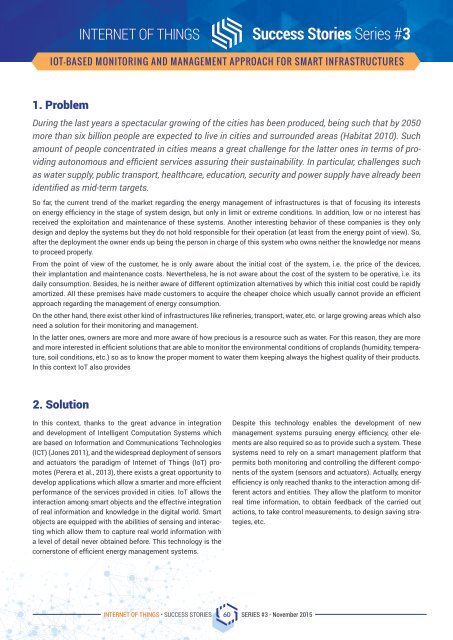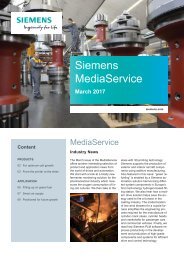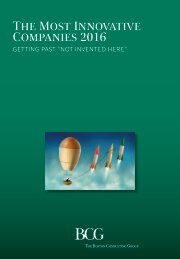Success Stories
VEZSJ
VEZSJ
Create successful ePaper yourself
Turn your PDF publications into a flip-book with our unique Google optimized e-Paper software.
Internet of Things <strong>Success</strong> <strong>Stories</strong> Series #3<br />
IoT-based Monitoring and Management Approach for Smart Infrastructures<br />
1. Problem<br />
During the last years a spectacular growing of the cities has been produced, being such that by 2050<br />
more than six billion people are expected to live in cities and surrounded areas (Habitat 2010). Such<br />
amount of people concentrated in cities means a great challenge for the latter ones in terms of providing<br />
autonomous and efficient services assuring their sustainability. In particular, challenges such<br />
as water supply, public transport, healthcare, education, security and power supply have already been<br />
identified as mid-term targets.<br />
So far, the current trend of the market regarding the energy management of infrastructures is that of focusing its interests<br />
on energy efficiency in the stage of system design, but only in limit or extreme conditions. In addition, low or no interest has<br />
received the exploitation and maintenance of these systems. Another interesting behavior of these companies is they only<br />
design and deploy the systems but they do not hold responsible for their operation (at least from the energy point of view). So,<br />
after the deployment the owner ends up being the person in charge of this system who owns neither the knowledge nor means<br />
to proceed properly.<br />
From the point of view of the customer, he is only aware about the initial cost of the system, i.e. the price of the devices,<br />
their implantation and maintenance costs. Nevertheless, he is not aware about the cost of the system to be operative, i.e. its<br />
daily consumption. Besides, he is neither aware of different optimization alternatives by which this initial cost could be rapidly<br />
amortized. All these premises have made customers to acquire the cheaper choice which usually cannot provide an efficient<br />
approach regarding the management of energy consumption.<br />
On the other hand, there exist other kind of infrastructures like refineries, transport, water, etc. or large growing areas which also<br />
need a solution for their monitoring and management.<br />
In the latter ones, owners are more and more aware of how precious is a resource such as water. For this reason, they are more<br />
and more interested in efficient solutions that are able to monitor the environmental conditions of croplands (humidity, temperature,<br />
soil conditions, etc.) so as to know the proper moment to water them keeping always the highest quality of their products.<br />
In this context IoT also provides<br />
2. Solution<br />
In this context, thanks to the great advance in integration<br />
and development of Intelligent Computation Systems which<br />
are based on Information and Communications Technologies<br />
(ICT) (Jones 2011), and the widespread deployment of sensors<br />
and actuators the paradigm of Internet of Things (IoT) promotes<br />
(Perera et al., 2013), there exists a great opportunity to<br />
develop applications which allow a smarter and more efficient<br />
performance of the services provided in cities. IoT allows the<br />
interaction among smart objects and the effective integration<br />
of real information and knowledge in the digital world. Smart<br />
objects are equipped with the abilities of sensing and interacting<br />
which allow them to capture real world information with<br />
a level of detail never obtained before. This technology is the<br />
cornerstone of efficient energy management systems.<br />
Despite this technology enables the development of new<br />
management systems pursuing energy efficiency, other elements<br />
are also required so as to provide such a system. These<br />
systems need to rely on a smart management platform that<br />
permits both monitoring and controlling the different components<br />
of the system (sensors and actuators). Actually, energy<br />
efficiency is only reached thanks to the interaction among different<br />
actors and entities. They allow the platform to monitor<br />
real time information, to obtain feedback of the carried out<br />
actions, to take control measurements, to design saving strategies,<br />
etc.<br />
Internet of Things • <strong>Success</strong> <strong>Stories</strong> 60 SERIES #3 - November 2015









